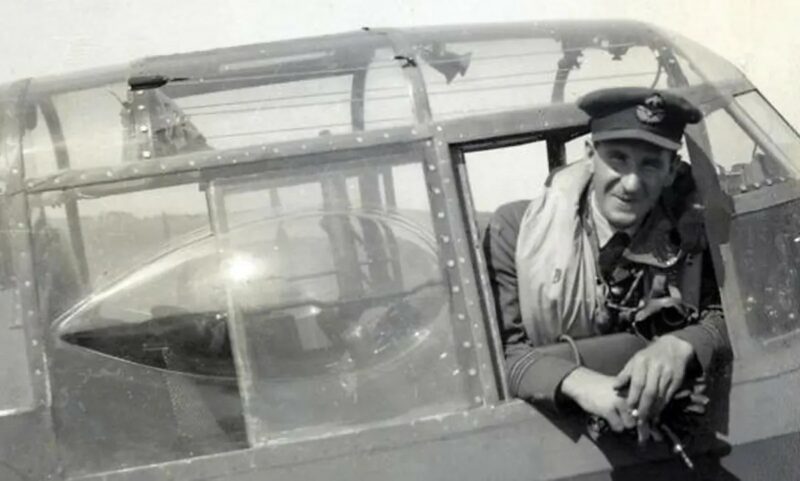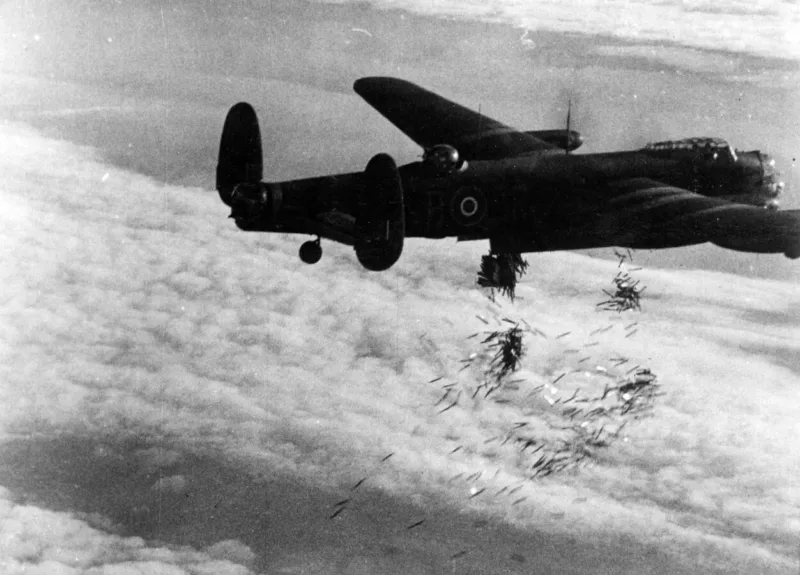Operations
Operations
Operation Taxable
Operation Taxable was a remarkable decoy operation flown in support of the D-Day landings. 617 Squadron, including New Zealand pilot Les Munro, was given a vital role in “Operation Taxable”. Their mission was intended to create a detailed and credible diversion, simulating an invasion fleet on German radar screens, intended to convince the enemy that the expected invasion would take place in the vicinity of Calais, some sixty miles to the east of the actual invasion force.

Les Munro hangs from the window of his Lancaster bomber during the second world war.
(Credit: PA)
Although 617 Squadron is mostly known for the Dams Raid it later carried out many other difficult operations where pin-point accuracy was required. These included canals, capital ships, U-boat pens, V1 and V2 rocket launching sites, railway yards, bridges and tunnels.
One of the lesser known but important operations was Operation Taxable which Les was part of. The aim was to fool the Germans to think an invasion fleet travelling at eight knots was heading to the Pas de Calais some sixty miles east of the Normandy landing site. Eight knots was the same speed as the Normandy fleet was advancing.
The War Cabinet had already approached both the Fleet Air Arm and Coastal Command. Both had replied that such a feat was impossible. The story goes that Bomber Command was asked to look at the idea. Its commander Sir Arthur Harris said, “Let 617 solve it and the rest of the Command can get on with fighting the war”.
The mission required four Lancasters to fly at an exact speed of 160 miles per hour at exactly three thousand feet towards the French Coast with two miles separation. All the aircraft had to turn right at exactly the same time and fly for exactly thirty-five seconds whilst bundles of ‘window’ (aluminium foil strips) were released every fifteen seconds.

A Lancaster dropping Window
(Credit: Imperial War Museum)
They then set a reverse course (towards England) before, at the right time, turning back towards France and repeating the window drop slightly ahead of the last drop. The new window was released just as the last drop hit the water. Another four Lancasters did the same behind the first wave to replicate the Normandy Fleet.
Over time it would appear that a fleet would be advancing towards France. It was so successful that the German shore batteries fired at the imaginary fleet and the whole area was placed on alert thus holding many troops from being transferred to Normandy saving many Allied lives.
Such was the precision required, each aircraft had to have two pilots and two navigators on the flight (Les’ relief pilot was Wing Commander Leonard Cheshire). Each wave was replaced after eight hours flying. In all there twelve crew members aboard plus the window so they were cramped conditions.
Les told me that the training and the flying for this operation was the most exacting and difficult he did as a pilot. Ironically, given its significance to the war effort, Taxable was not considered an official operation in his logbook as they did not cross the enemy coast.
Munro later wrote, “I have always considered the operation in one sense to be the most important the squadron carried out in my time – not because [of] bad weather, nor because of any threat of enemy action and not measured by any visible results, but because of the very exacting requirements to which we had to fly and navigate.”
Max Lambert’s “Victory” records that Cheshire, soon to be awarded a Victoria Cross, signed Munro’s logbook noting ‘Certified S/L Munro is still in possession of most of his faculties after completing the operation described on this page.’
Editor’s note: For training, crews had been sent off on cross-country flights across England to practice. No Window was dropped, but anyone on the ground might have been puzzled, seeing a Lancaster orbiting seemingly pointlessly overhead for an hour at a time.
Pilots had to be able to fly identical orbits, making perfectly timed turns for circuit after circuit. Accurate height also had to be maintained, facilitated by the use of a radio altimeter, along with constant airspeed.
Any error in timing on the day would cause the German radar image of the ‘convoy’ to suspiciously change position or appear to increase speed. It was tiring, monotonous work, requiring intense concentration.

Graphic of deception operations on the night of 5/6 June ahead of Overlord, Deception operations, including the Taxable and Glimmer ‘fake fleets’, and Mandrel jamming aircraft. Operation Titanic involved dropping half size mannequins ‘Ruperts’ behind enemy lines in northern France.
(Credit: Ministry of Defence DEFE2/502)